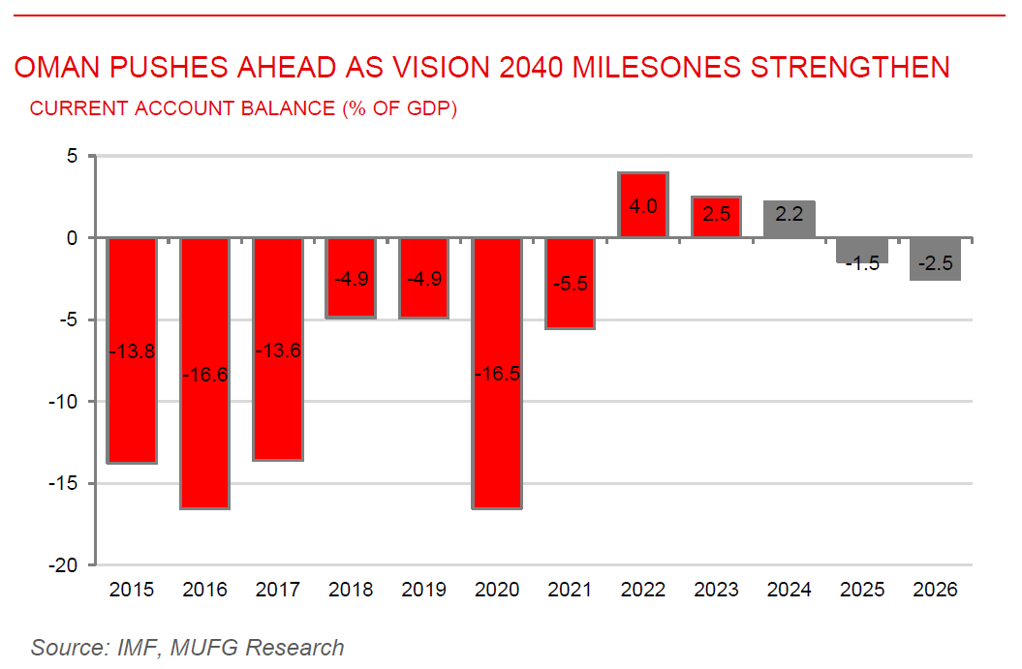To read the full report, please download the PDF above.
Middle East Daily
SOOJIN KIM
Research Analyst
DIFC Branch – Dubai
T: +44(4)387 5031
E: soojin.kim@ae.mufg.jp
MUFG Bank, Ltd. and MUFG Securities plc
A member of MUFG, a global financial group
Middle East Daily
COMMODITIES / ENERGY
Oil market steadies as oversupply and Russia sanctions shape outlook. Oil prices steadied after a two-day slump, with Brent trading just below USD66/b and WTI near USD61/b, as the market balanced rising evidence of a supply glut against the fallout from newly imposed US sanctions on major Russian producers. Global crude shipments by sea have climbed to a record high, signalling persistent excess barrels even as OPEC+ considers adding more output at its upcoming meeting. While sanctions initially boosted prices, the US’s goal is to make Russian exports riskier and more expensive without causing a price spike. The market remains under pressure heading toward a third straight monthly decline, with both OPEC+ members and other producers increasing supply. Traders are also closely watching US-China trade negotiations ahead of a planned leader-level summit, contributing to price weakness for the grade.
Gold recovers slightly after sharp selloff on trade optimism. Gold regained some ground after plunging below USD4,000/oz as progress in US-China trade negotiations reduced demand for safe-haven assets. Gold rose up to 0.9% today, following a 3.2% drop the previous session when both sides reported agreements on tariffs and export controls. Higher US treasury yields also pressured the non-yielding asset, even as markets continued to expect another 25bps Fed rate cut this week. Although gold has retreated sharply from a record above USD4,380/oz, it remains up more than 50% YTD, supported earlier by central bank buying and investor concern over fiscal deficits. Silver also advanced after steep losses, while platinum edged lower and palladium gained.
MIDDLE EAST - MACRO / MARKETS
Oman’s diversification drive gains traction under Vision 2040. According to the 4th periodic progress report released by the Oman Vision 2040 Implementation Follow-up Unit, 74% of the national performance indicators show concrete advancement toward their respective targets. The report highlights major strides across multiple pillars under the People and Society pillar, innovation include a rise in Omani universities’ global rankings, increased international accreditation of private institutions, and enhancements in the national technical and vocational education framework. In the Economy and Development pillar, non-oil sectors comprised 72.8% of GDP in 2024, with manufacturing growing 8.3% and agriculture and fisheries 2.8%, while the current account surplus reached 1.83%, exceeding the earlier target of -7%. On the Environment and Sustainable Development front, Oman key clean-energy projects, reinforcing its net-zero strategy. The comprehensive update confirms that while execution remains a challenge, strong implementation momentum now underpins the country’s medium-term economic and diversification trajectory.
UAE cabinet approves largest federal budget in nation’s history. The UAE Cabinet approved the 2026 Federal budget with AED92.4bn in both projected revenues and expenditures, representing a 29% increase compared with the 2025 budget, making it the largest federal budget ever adopted. The budget prioritises national objective with AED34.6bn (37%) allocated to social development and pensions, AED27.1bn (29%) for government affairs, AED15.4bn (17%) toward financial investments, AED12.7bn (14%) for federal expenses, and AED2.6bn (3%) supporting infrastructure and economic development. The Cabinet also reviewed performance of the National Agenda for Outbound Direct Investment, confirming that the cumulative balance of outbound FDI reached AED 1.05 trillion by the end of 2024, reflecting 9% y/y growth, placing the UAE first in the Arab world and among the top 20 global outbound investors. In addition, the value of non-oil trade with priority partner markets more than doubled, climbing from AED469.3bn in 2019 to AED952.6bn in 2024, supported by Comprehensive Economic Partnership Agreements (CEPA) and export-development initiatives. Overall the decision reflect the UAE’s commitment to fiscal responsibility, stronger global economic positioning, and a confident trajectory toward sustainable, diversified growth in the years ahead.
UK-GCC trade deal nearing completion, UK Finance Minister says. UK Finance Minister Rachel Reeves said she is confident a trade deal with GCC nations can be finalised “very soon” after productive discussions in Saudi Arabia that included counterparts from Bahrain, Kuwait, and Qatar. Reeves pointed to the potential size of the deal, estimated to generate around USD2.2bn annually for the UK economy, equivalent to about 0.06% of GDP. She said the deal would support her broader growth agenda and will build on growing British-GCC investment ties, including the UK’s expectation of further capital commitments from the Gulf region.
Bahrain inflation stabilise in September 2025. Bahrain’s CPI returned to 0.0% y/y in September, improving from -0.8% in August. The move out of deflation suggest price pressures are gradually stabilising after months of subdued consumer demand and easing costs in key spending categories.

